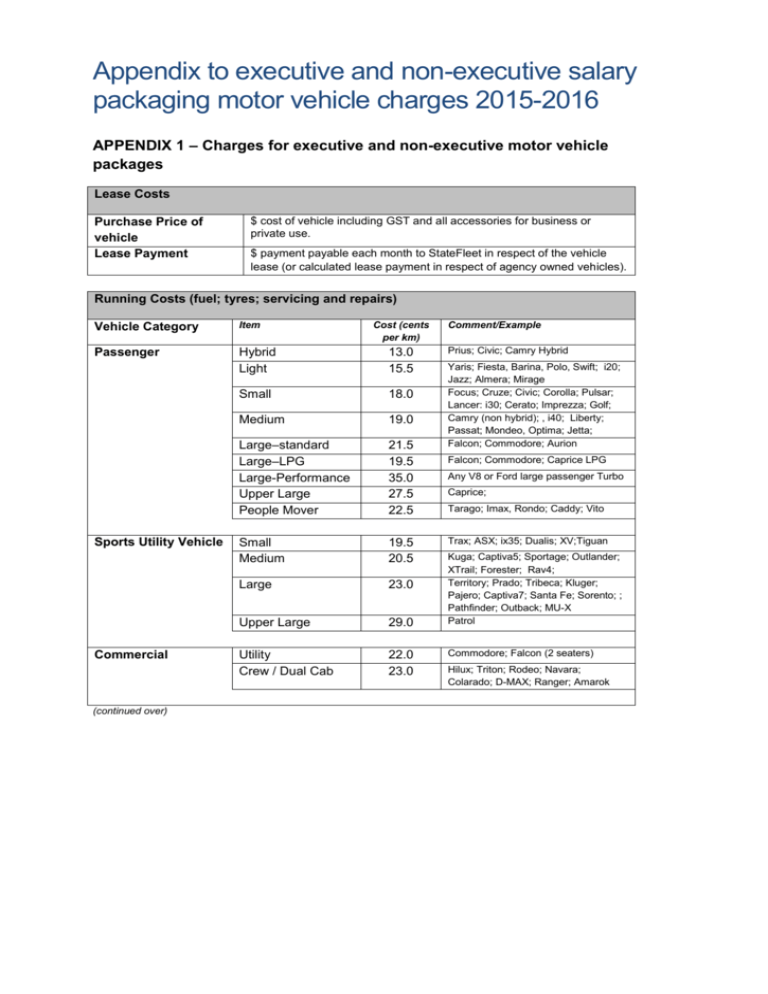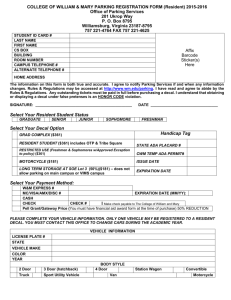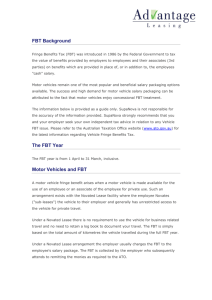Appendix to executive and non-executive salary packaging motor
advertisement

Appendix to executive and non-executive salary packaging motor vehicle charges 2015-2016 APPENDIX 1 – Charges for executive and non-executive motor vehicle packages Lease Costs Purchase Price of vehicle Lease Payment $ cost of vehicle including GST and all accessories for business or private use. $ payment payable each month to StateFleet in respect of the vehicle lease (or calculated lease payment in respect of agency owned vehicles). Running Costs (fuel; tyres; servicing and repairs) Vehicle Category Item Passenger Hybrid Light 13.0 15.5 Small 18.0 Medium 19.0 Large–standard Large–LPG Large-Performance Upper Large People Mover 21.5 19.5 35.0 27.5 22.5 Small Medium 19.5 20.5 Large 23.0 Upper Large 29.0 Utility Crew / Dual Cab 22.0 23.0 Sports Utility Vehicle Commercial (continued over) Cost (cents per km) Comment/Example Prius; Civic; Camry Hybrid Yaris; Fiesta, Barina, Polo, Swift; i20; Jazz; Almera; Mirage Focus; Cruze; Civic; Corolla; Pulsar; Lancer: i30; Cerato; Imprezza; Golf; Camry (non hybrid); , i40; Liberty; Passat; Mondeo, Optima; Jetta; Falcon; Commodore; Aurion Falcon; Commodore; Caprice LPG Any V8 or Ford large passenger Turbo Caprice; Tarago; Imax, Rondo; Caddy; Vito Trax; ASX; ix35; Dualis; XV;Tiguan Kuga; Captiva5; Sportage; Outlander; XTrail; Forester; Rav4; Territory; Prado; Tribeca; Kluger; Pajero; Captiva7; Santa Fe; Sorento; ; Pathfinder; Outback; MU-X Patrol Commodore; Falcon (2 seaters) Hilux; Triton; Rodeo; Navara; Colarado; D-MAX; Ranger; Amarok APPENDIX 1 (continued) Standing Costs Element Item Cost Comment/Example Comprehensive Insurance (includes GST) Passenger SUV/Commercial 757 833 See Running Cost list above Compulsory Third Party Insurance (includes GST) Sydney Wollongong Newcastle/Cent Cst Country 532 447 382 379 Greater metropolitan area Registration fee including Tare Weight Tax (GST Exempt) Up to 975kg 386 976 – 1154kg 431 1155 – 1504kg 509 1505 – 2504kg 736 NRMA membership (includes GST) Joining Fee Annual fee Fee for Service 55 105 0 Taxation Parking Tax (as issued by the OSR at 1st July each year ) From 1st July 2014 Category 1 $2,260 Category 2 $800 FBT Factors Gross up factor Top tax rate Statutory Factor No km limit See Running Cost list above “ “ “ “ “ “ Yaris 1.3 Fiesta; Corolla; Barina; Camry; Cruze; Forester; Prius; Commodore; Falcon; Aurion ; Outback; Pajero; Landcruiser etc Only applied in first year – rarely used Mostly used in calculation for NSW Govt Sydney; North Syd; Milsons Point Parra; Chatswood; Bondi J; St Leonds 1.9608 49% 20% (0.20) For packages established after 10 May 2011 at 7:30pm. APPENDIX 2: Notes on motor vehicle packages 2015–2016 PRE 10TH MAY 2011 and POST 10TH MAY PACKAGES In 2011 the Federal Government changed the FBT legislation. Where a package existed under the old rates, that is an existing package existed before 10 May 2011 at 7.30pm, the old statutory formula rates applied and will apply until the lease terminates or changes are made to the lease that constitute a new ‘commitment’. As there are now so few packages using these rates, this section has been removed. See previous circular for details. (DFS-C2014-2) The flat rate of 20% applies to all new ‘commitments’ to provide a car. LEASE FEE A “lease fee” figure must be included in the calculation of a package regardless of whether the vehicle is leased from StateFleet or agency owned. This is because there is a cost to the agency for that vehicle even when it is owned. No package is to be calculated with a minimal or agency determined lease fee. As such, for agency owned vehicles, a lease calculation must be obtained from StateFleet for an equivalent make/model and term based on kilometres to be travelled annually so charges remain consistent across government. Where an agency has calculated an internal lease rate consistent with industry lease calculations, this also should be confirmed with StateFleet. The lease payment must include GST. PARKING SPACE LEVY The Parking Space Levy is a charge on non-residential parking spaces within business districts specified in the Parking Space Levy Act 2009. The Parking Space Levy is not the cost of the parking space, but a levy on parking spaces in major Sydney CBD locations. Parking Space Levy fees apply from 1 July each year. These are generally advised by a separate Circular. The Parking Space Levy is to be collected in full from the officer who has a vehicle under a salary sacrifice arrangement and who is provided with a parking space where the levy applies. There is no proportioning of the levy (eg by business/private split). The only “proportioning” that would occur is at a reconciliation of a package where the officer has not held the spot for the entire FBT year. In almost all instances, there would be no exemption in accordance with clause 7 of the Parking Space Levy Regulation 2009. Any request for exemption for an officer should be referred to the contacts in this Circular. (See also note in Appendix 3 under Taxation on the calculation and collection of the Parking Space Levy over whole year) CHANGES IN CHARGES FROM PREVIOUS CIRCULAR Running Costs There has been no change to Running Costs as the price of fuel has gone down offsetting maintenance cost increases over the last 12 months. The fuel rate used in the calculations is from the NSW Government Fuel contract. The price excludes GST. The figures in Appendix 1 reflect these balancing changes. Standing Costs CTP insurance is provided by contract to the NSW Government and the prices in Appendix 1 reflect the contract figures. Weight Taxes have increased also which is why Registration costs have increased. Comprehensive insurance charges are provided by GIO on behalf of the Treasury Managed Fund and reflect claims history and future liabilities. They have decreased since last year. Input tax credits (ITC) are available for CTP insurance. Since 1 July 2003, CTP insurers have been issuing tax invoice for policies commencing after 30 June 2003 and GST registered entities will be entitled to claim an ITC on the GST component. Tax Rate changes The 2013 increase in the Medicare levy of 0.5% to 2%, which applied from the 2014/2015 FBT year, is still in place resulting in an increase of the FBT rate to 47% from 1 April 2014. The type 1 and 2 gross up factors were also impacted by the change. The new Type 1 gross up factor is 2.1463 and the type 2 gross up factor is 1.9608. RECONCILIATION Reconciliation of all packages is to be done as at 31 March (end of FBT year). Reconciliation requires the package to be recalculated based on closing FBT year information and reconciliation against the estimate provided to the officer. There may be further recovery from the officer or monies returned depending upon the outcome of the reconciliation. When the package is reconciled, the FBT liability can be calculated using the Statutory Method or the Operating Cost method. The method that provides the lowest FBT amount payable can be used. The Operating Cost method should only be used when a valid log book has been maintained by the officer. Please note: all reconciliation payments must be made before the end of the financial year and the RFB amount put on the officers payment summary. REPORTABLE FRINGE BENEFITS In accordance with DPC Circular 2000-46, the FBT charge for salary packaging arrangements in all government agencies will continue to be determined using the lower gross-up rate (from April 2014 = 1.8868). Under this scenario, the employee bears the GST inclusive cost of relevant expenses, but is only charged FBT using the lower FBT gross-up rate. Because the employee will only be charged FBT using the lower gross-up rate, the employee will not be entitled to any Input Tax Credits (ITC) that may be available to the agency. On the other hand, agencies (the employers) will be required to pay FBT to the Commonwealth using the applicable FBT gross-up rate, generally the Type 1 rate (now 2.0802) and retain any ITC, if available. The RFB figure placed on the officer’s payment summary will be calculated using the higher Gross up rate. POOLED CAR BENEFIT Since 1 April 2007, pooled car fringe benefits, if exempt, do not need to be reported on the employee's payment summary. A pooled or shared car is one provided by an employer for the private use of two or more employees. It is not NSW Government policy to have individual salary packaging arrangements that result in a car benefit for more than one employee. APPENDIX 3: Components in calculating a package Purchase Price and FBT The purchase price is the invoiced value of the vehicle including all accessories and options whether used for business or private use. Accessories are those generally purchased from a dealer or third party as options or after market fittings (eg towbar, driving lights etc). StateFleet leased vehicles generally have the accessories included in the capital cost. For agency owned vehicles, which are subsequently salary sacrificed, the accessories must be added into the purchase price for the calculation of the package and FBT. Under tax law any accessory added after the vehicle is purchased must be added into the capital cost of the vehicle. The NSW Government previously decided that the FBT charge for salary packaging arrangements in all Government agencies will use the lower gross up rate. Under this arrangement the employee bears the GST inclusive cost of relevant expenses, but is charged FBT at the lower rate. As such GST is included on those items not exempt from the payment of GST. Lease Payments The lease payment is a calculated fee incorporating the components of purchase price, residual value, Treasury interest rates and the lease term of the vehicle. The lease payment also includes GST. Running Costs The running costs on the vehicle are calculated to include the cost of fuel, servicing, general maintenance such as oil and tyres, and repairs (non-insurance). The vehicle categories in Appendix 1 are consistent with Australian Bureau of Statistics reporting categories for motor vehicles and the industry standards. As such the Sports Utility Vehicle (SUV) category is included and consolidates the 4WD and AWD. Vehicles categorised as commercial, which are salary sacrificed, are not exempt from the payment of FBT under the FBT Assessment Act 1986. As such they are to be treated in the same way as ‘passenger’ vehicles and costed accordingly. Standing Costs CTP is applicable and paid based on the agency garaging address of the vehicle and not the private officer’s address. For vehicles leased from StateFleet, the initial registration fee is included in the lease fee for that year. This has in the past caused some confusion for agencies/departments. StateFleet have developed a simpler arrangement that will assist and agencies/departments should use the following formula to remove the registration fee from the StateFleet lease fee. When the adjusted lease fee is used in package calculations, the officer should be charged the full registration fee in the package as listed in this Circular. This is the recommended approach. NRMA membership is applied to packages where an agency has a specific account with the NRMA and pays the annual fee for the car to be covered. If an agency has elected to have a “Fee for Service” arrangement with the NRMA, no cost is payable by the officer. Where a manufacturer has a “roadside assist package” as part of the vehicle cost, similarly no fee is to be charged to the officer. The majority of packages will be costed as “Fee for Service”. Taxation The Office of State Revenue (OSR) revises the Parking Space Levy annually for parking spaces in prime business districts. The levy commences on 1 July annually. Whilst it is in accordance with Government policy to recover the full cost of the levy, the salary package does not have to be adjusted to accommodate the two different rates which may apply over the FBT year as this is administratively time consuming and not worth the minor cost change. For packages created before the 1st July of the applicable year the old rates can be used for the whole year and for those created after the 1st July the new rates should apply. The ‘gross up factor’ has been amended and from 1 April 2014 will be 1.8868. The FBT tax rate has also been amended and will be 0.47 (47%) also from 1 April 2014. The NSW Government has previously determined it will use the lower gross up rate in vehicle salary packaging arrangements. The Statutory Factor is used in the Statutory Method calculation for FBT and is used in estimating package costs. Reconciliation Calculation The calculator has a reconciliation sheet. This sheet can calculate on Statutory Factor or Operating Costs. If Operating Costs are known then then can be input and the lower rate will be used in the calculation. A minimum number of costs need to be entered for the operating costs calculation to be performed. Where an officer may hold two vehicles packages over the year, both vehicle packages must be calculated separately and then the total reconciliation determined by joining of both sets of final figures. APPENDIX 4 MOTOR VEHICLE SALARY SACRIFICE PACKAGE CALCULATOR Agencies /Departments have the option of using their own spreadsheet or database to calculate packages. An electronic calculator is available from StateFleet. The calculator (2014 example below) is provided to identify the formulas and method of calculation to be used in determining a package cost and to maintain consistency across Government agencies/departments. The spreadsheet calculator is available from StateFleet (see main Circular for contact).









